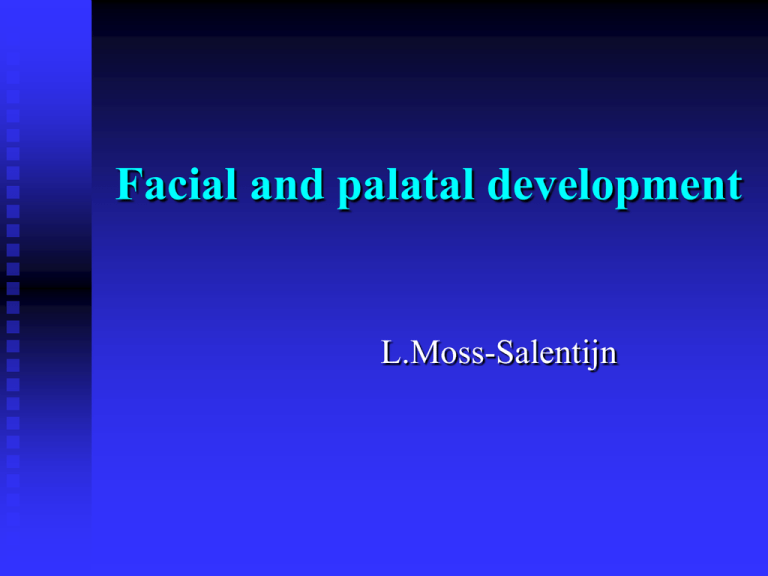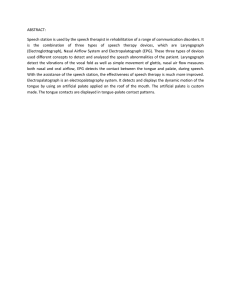Facial and palatal development L.Moss-Salentijn
advertisement

Facial and palatal development L.Moss-Salentijn Timeline for development Secondary palate Completion of soft palate Primary palate External face Pharyngeal arches 4 wks 6 wks 8 wks 12 wks Decrease of severity of potential congenital malformations Contributions to the external face Periprosencephalon: ectoderm and mostly ncderived mesenchyme surrounding the forebrain. Frontonasal process. First pharyngeal (mandibular) arch. Mandibular and maxillary processes. Contributions to external face In periprosencephalon: cells from anterior neural fold and neural crest from midbrain. Oropharyngeal membrane (buccopharyngeal, oral) Membrane is composed of ectoderm and endoderm. Disintegration of oropharyngeal membrane Communication between foregut and amniotic cavity at approximately 4 weeks of development. Stomodeum at 4 weeks Facial processes (prominences) Bilaterally: Lateral nasal Medial nasal Maxillary Mandibular Connexin (gap junctions!) expression in the facial processes at different stages of chick face development. These are the cell groups that contribute most to the overall expansion of the facial processes. Development external face (4-5 wks) Development external face (6-8 wks) Face development - animation Dimensional changes (4-6 wks) 10-fold linear increase in size ! Merging Differential mesenchymal proliferation. Elimination of groove. Merging with epithelial inclusion May result in facial cleft. May be normal between LNP and maxillary process where enclosed epithelium gives rise to part of nasolacrimal duct epithelium. Sites of potential facial clefts Fusion Contact and fusion of epitheliumcovered surfaces. Removal of epithelium Fusion in primary and secondary palate development Fate of fused epithelium Non-proliferating epithelium in rapidly growing environment: passive stretch and incorporation in nearby surface epithelia Apoptosis and phagocytosis Epithelial-mesenchymal transformation (?) Development of nose Initial fusion of medial and lateral nasal processes, and subsequently between medial nasal and maxillary processes. Disappearance of epithelium in fusion line. All epithelium in fusion line is removed except oronasal membrane (ectoderm-ectoderm) Oronasal membrane Breaks down at about 6 wks of development. Primary (primitive) palate Primary palate composed of: intermaxillary segment of merged MNP’s and the rostral tips of the maxillary processes. P: primary (primitive) choana permitting oro-nasal communication. Development of primary and secondary palate Secondary palate development Intrinsic factors in the successful development of the secondary palate: increase in size of palatal processes Mesenchymal cell proliferation – ceases hours before palatal processes become horizontal ECM production increasing volume of palatal processes Hydration of ECM – major increase in volume and turgor just prior to horizontalization Secondary palate development Palatal processes develop on the oral surfaces of the maxillary processes: initially vertically oriented, they assume horizontal orientation during eighth week of development. Horizontalization of palatal processes Factors contributing to the horizontalization of the palatal processes Turgor in the palatal processes Movements of the tongue – primitive swallowing- allowing tongue to move out of the way Downward and forward growth of lower jaw complex – providing space for the secondary palate Straightening of the cranial base – providing mechanical conditions for horizontalization Factors contributing to the successful fusion of the secondary palate: the medial edge epithelium (MEE) Apoptosis of MEE surface cells immediately prior to fusion Development of temporary glycoprotein membrane coating, enabling adhesion between MEE cells of opposing palatal processes Successful removal of MEE from fusion line Fate of MEE cells: apoptosis (TUNEL reaction above) and phagocytosis Non-proliferating epithelium in rapidly growing environment: passive stretch and incorporation in nearby surface epithelia Completion of palate formation Sites of potential palatal clefts

